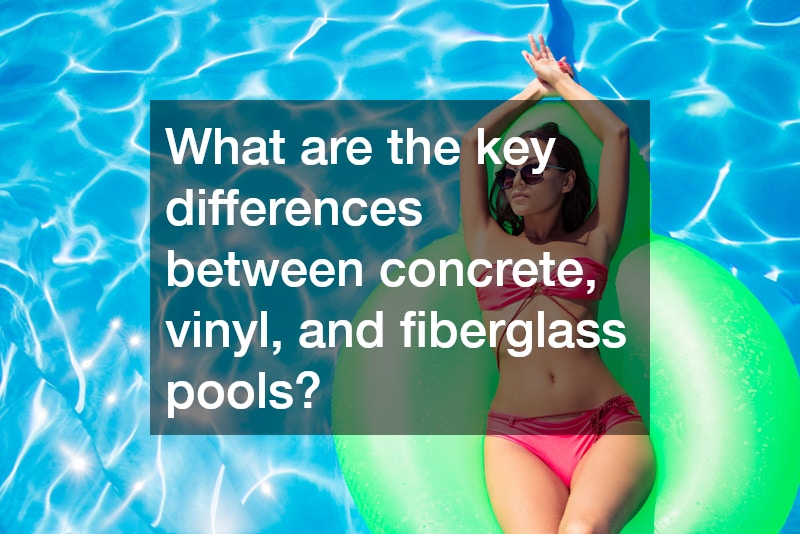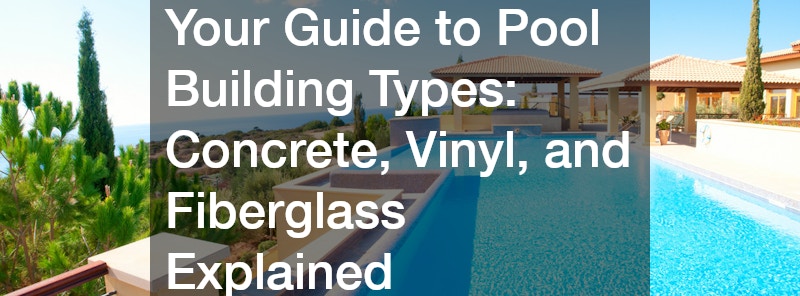Building a pool can be a complex decision, with numerous materials and construction types to consider. This guide will explore the three major pool building types: concrete, vinyl, and fiberglass. Understanding the differences among these materials can help you decide on what best suits your lifestyle, budget, and aesthetic preferences.
What are the key differences between concrete, vinyl, and fiberglass pools?
Concrete Pools
Concrete pools are highly durable and customizable, allowing for a wide range of shapes and sizes. This construction process typically involves layering concrete over a steel framework, which creates a robust and stable structure. These pools often appeal to those looking for unique, tailored designs that fit specific backyard landscapes.
The design flexibility of concrete pools extends to the choice of finishes, including plaster, pebble, or tile. Such options can significantly enhance the aesthetic appeal, making them a popular choice among homeowners who prioritize design. Additionally, concrete pools can accommodate a variety of features like built-in spas, waterfalls, and tanning ledges.
Vinyl Pools
Vinyl pools are known for their smooth surfaces and cost-effectiveness, offering a budget-friendly option for many families. The installation process includes placing a flexible liner over a supportive framework, which can be steel, polymer, or concrete. Though initially less expensive, it’s important to consider the cost of future liner replacements when planning your budget.
These liners are available in various colors and patterns, adding a personal touch to your pool’s design. However, they are susceptible to tears and punctures, making careful use necessary to maintain their integrity. With proper maintenance, a vinyl liner can last up to 10 years before needing replacement, providing a window of reliable use.
Fiberglass Pools
Fiberglass pools, which are pre-fabricated in a factory and transported to your home in a single unit, are known for their quick installation process. Within days of excavation, your fiberglass pool can be set into place, significantly minimizing labor time and disruption. Homeowners appreciate their seamless finish, which reduces the likelihood of algae growth and keeps maintenance simple.
The smooth surface of fiberglass pools not only enhances comfort but also reduces the need for extensive cleaning and chemical usage. They are highly resistant to common issues like cracking, ensuring a long-lasting solution for families seeking minimal upkeep. However, it’s essential to consider the limited customization options in terms of size and shape compared to concrete pools.
Which pool type is best for durability and maintenance?
Concrete pools are renowned for their longevity, often lasting over 30 years with proper maintenance. The robust construction and customization options bolster their long-term appeal for those looking to invest in a permanent backyard fixture. Resurfacing every decade or so can significantly prolong the life and appearance of these pools, although this can be a costly endeavor.
Durability factors for concrete pools include the quality of materials used, climate conditions, and regular upkeep practices. Concrete is susceptible to cracking, especially in regions with fluctuating temperatures, but attentive care can prevent costly repairs. Homeowners should plan for regular inspections to catch potential issues early on and maintain their pool’s integrity.
Concrete pools require consistent cleaning and chemical balancing to prevent algae and mineral buildup. The porous nature of concrete means it can easily harbor bacteria, necessitating more attentive maintenance than other pool types. While this may be a drawback for some, others find the sturdy, timeless appeal of concrete worth the extra effort.
Regular vacuuming and skimming are essential to keep the vinyl liners clean and free from debris that could cause damage. Maintaining proper water chemistry not only keeps the liner in good shape but also ensures a safe, comfortable swimming environment. However, potential owners should factor in periodic liner replacements as part of their long-term maintenance budget.
How do costs compare for installation and upkeep among the three types?
Concrete pools generally command a higher initial investment due to complex construction processes and labor demands. The flexibility in design and durability often justify these costs for those seeking a tailored outdoor space. However, buyers must weigh these benefits against the substantial maintenance expenses that accumulate over time.
Factors influencing costs include the pool’s size, depth, shape, and any additional features such as decking, lighting, or water elements. These additions can significantly drive up the price but simultaneously enhance the functionality and aesthetics of the pool area. Typically, owners spend more annually on maintenance for concrete than other types, making it crucial to budget for this ongoing expense.
Deciding between concrete, vinyl, and fiberglass involves weighing initial costs, long-term maintenance, and personal preferences. Each type has distinct advantages and potential drawbacks, making the choice a personalized one based on your specific needs. By considering all factors involved, including your budget, desired features, and maintenance willingness, you can confidently select the pool type that best aligns with your vision.






